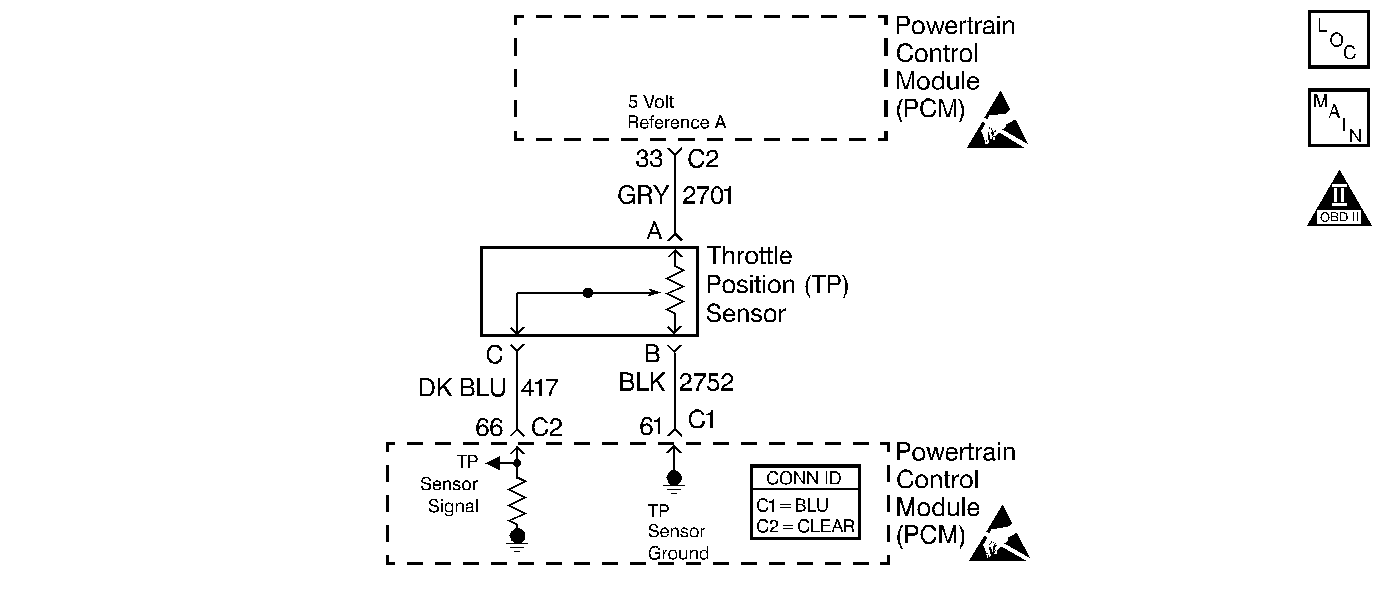
Circuit Description
The Throttle Position (TP) sensor circuit provides a voltage signal that changes relative to throttle blade angle. The signal voltage will vary from below 1.0 volts at closed throttle to above 4.0 volts at Wide Open Throttle (WOT).
If the PCM detects an excessively high TP Sensor voltage, DTC P0123 will be set.
Conditions for Running the DTC
The ignition is on.
Conditions for Setting the DTC
| • | TP sensor signal voltage is greater than 4.9 volts. |
| • | The above conditions present for more than 10 seconds. |
Action Taken When the DTC Sets
| • | The PCM illuminates the malfunction indicator lamp (MIL) on the second consecutive ignition cycle that the diagnostic runs and fails. |
| • | The PCM records the operating conditions at the time the diagnostic fails. The first time the diagnostic fails, the PCM stores this information in the Failure Records. If the diagnostic reports a failure on the second consecutive ignition cycle, the PCM records the operating conditions at the time of the failure. |
| • | The PCM writes the conditions to the Freeze Frame and updates the Failure Records. |
Conditions for Clearing the MIL/DTC
| • | The PCM will turn OFF the malfunction indicator lamp (MIL) during the third consecutive trip in which the diagnostic has run and passed. |
| • | The history DTC will clear after 40 consecutive warm-up cycles have occurred without a malfunction. |
| • | The DTC can be cleared by using a scan tool. |
Diagnostic Aids
Check for the following conditions:
Faulty TP sensor: With the key on, engine off, observe the TP sensor display on the scan tool while slowly depressing the accelerator to wide open throttle. If a voltage over 4.90 volts is seen at any point in normal accelerator travel, replace the TP sensor.
Important: : Remove any debris from the connector surfaces before servicing a component. Inspect the connector gaskets when diagnosing or replacing a component. Ensure that the gaskets are installed correctly. The gaskets prevent contaminate intrusion.
| • | Poor terminal connection. |
| Inspect the harness connectors for backed out terminals, improper mating, broken locks, improperly formed or damaged terminals, and faulty terminal to wire connection. Use a corresponding mating terminal to test for proper tension. Refer to Intermittents and Poor Connections Diagnosis , and Connector Repairs Wiring Systems. |
| • | Damaged harness. |
| Inspect the wiring harness for damage. If the harness appears to be OK, observe the sensor display on the scan tool while moving connectors and wiring harnesses related to the sensor. A change in the sensor display may indicate the location of the fault. Refer to Wiring Repairs in Wiring Systems. |
| • | Inspect the PCM and the engine grounds for clean and secure connections. |
If the DTC is determined to be intermittent, reviewing the Fail Records can be useful in determining when the DTC was last set.
Test Description
The numbers below refer to the step numbers on the Diagnostic Table:
Step | Action | Value(s) | Yes | No |
|---|---|---|---|---|
1 | Was the Powertrain on-Board Diagnostic Test performed? | -- | ||
2 |
Is TP Sensor above the specified value? | 4.9V | ||
3 |
Does scan tool indicate DTC P0123 failed this ignition? | -- | Go to Diagnostic Aids | |
4 |
Is the TP Sensor near the specified value? | 0.0V | ||
5 | Probe the sensor ground circuit at the TP sensor harness connector with a J 35616-200 test light connected to battery positive voltage. Is the J 35616-200 test light on? | -- | ||
6 |
Was the TP sensor signal circuit shorted? | -- | ||
Does disconnecting any of these components cause the TP Sensor display to change? | -- | |||
8 |
Was the 5 Volt Reference A circuit shorted? | -- | ||
9 | Test for poor electrical connections at the TP sensor and PCM and replace terminals if necessary or open sensor ground circuit. Refer to Testing for Continuity , Intermittents and Poor Connections Diagnosis , Repairing Connector Terminals , and Connector Repairs . Did any terminals or ground circuit require repair? | -- | ||
10 | Replace the TP sensor. Refer to TP Sensor Replacement . Is the action complete? | -- | -- | |
|
Important: : Replacement PCM must be programmed. Refer to Powertrain Control Module Replacement/Programming . Replace the PCM. Is the action complete? | -- | -- | ||
12 |
Does scan tool indicate DTC P0123 failed? | -- | System OK |
